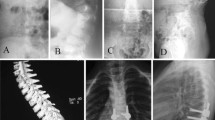Abstract
Purpose
To investigate incidence, risk factors, and complications of vertebral subluxation (VS) during three-column osteotomy in surgical correction of adult spine deformity.
Methods
Adult spine deformity patients who underwent three-column osteotomies including VCR, PSO, and other modified types from March 2000 to December 2014 in our center were retrospectively reviewed. The following parameters were measured pre- and postoperatively: Cobb angle of main curve, global kyphosis, sagittal vertical axis, and kyphosis flexibility. Radiographic parameters between groups (VCR vs. PSO and subluxation vs. non-subluxation) were compared.
Results
171 ASD patients were recruited, 18 of which (10.5%) developed sagittal vertebral subluxation at the osteotomy site. 5 of 18 patients (27.8%) developed neurological complications after surgery. For these five patients, two patients got partial recovery, and three got complete recovery at 2-year follow-up. 116 patients underwent PSO, 12 of which (10.3%) developed sagittal vertebral subluxation. In 55 patients receiving VCR, 6 (10.9%) developed sagittal vertebral subluxation. No significant difference was noted between the two groups (P > 0.05). The mean age of VS group was larger than that of non-VS group (46.2 vs. 34.2, P < 0.05). VS group had less kyphosis flexibility (11 vs. 23%, P < 0.05). More patients in VS group had preoperative sagittal VS as compared to non-VS group (77.8 vs. 20.9%, P < 0.05). VS group had more neurological complications than non-VS group (25 vs. 5.4%, P < 0.05).
Conclusion
VS occurred in one-tenth of patients receiving three-column osteotomies, one-fourth of which would develop neurological deficits. Older age, rigid kyphosis, and the pre-existence of VS were risk factors for developing VS.



Similar content being viewed by others

References
Aebi M (2005) The adult scoliosis. Eur Spine J 14:925–948
Koller H, Pfanz C, Meier O, Hitzl W, Mayer M, Bullmann V, Schulte TL (2016) Factors influencing radiographic and clinical outcomes in adult scoliosis surgery: a study of 448 European patients. Eur Spine J 25:1–17
Daubs MD, Lenke LG, Cheh G, Stobbs G, Bridwell KH (2007) Adult spinal deformity surgery: complications and outcomes in patients over age 60. Spine (Phila Pa 1976) 32:2238–2244
Hassanzadeh H, Jain A, El Dafrawy MH, Ain MC, Mesfin A, Skolasky RL et al (2013) Three-column osteotomies in the treatment of spinal deformity in adult patients 60 years old and older: outcome and complications. Spine (Phila Pa 1976) 38:726–731
Diebo BG, Lafage R, Ames CP, Bess S, Obeid I, Klineberg E et al (2016) Ratio of lumbar 3-column osteotomy closure: patient-specific deformity characteristics and level of resection impact correction of truncal versus pelvic compensation. Eur Spine J 20:1–8
Schwab F, Blondel B, Chay E, Demakakos J, Lenke L, Tropiano P et al (2013) The comprehensive anatomical spinal osteotomy classification. Neurosurgery 76:112–120
Buchowski JM, Bridwell KH, Lenke LG, Kuhns CA, Lehman RA, Kim JY, Stewart D, Baldus C (2007) Neurologic complications of lumbar pedicle subtraction osteotomy a 10-year assessment. Spine 32:2245–2252
Yang BP, Ondra SL, Chen LA, Jung HS, Koski TR, Salehi SA (2006) Clinical and radiographic outcomes of thoracic and lumbar pedicle subtraction osteotomy for fixed sagittal imbalance. J Neurosurg Spine 5:9–17
Ayhan S, Aykac B, Yuksel S, Guler UO, Pellise F, Alanay A et al (2016) Safety and efficacy of osteotomies in adult spinal deformity: what happens in the first year? Eur Spine J 25:1–9
Hamilton DK, Smith JS, Sansur CA, Glassman SD, Ames CP, Berven SH et al (2011) Rates of new neurological deficit associated with spine surgery based on 108,419 procedures. Spine (Phila Pa 1976) 36:1218–1228
Lenke LG, O’Leary PT, Bridwell KH et al (2009) Posterior vertebral column resection for severe pediatric deformity: minimum two-year follow-up of thirty-five consecutive patients. Spine (Phila Pa 1976) 34:2213–2221
Qian BP, Mao SH, Jiang J, Wang B, Qiu Y (2017) Mechanisms, predisposing factors, and prognosis of intraoperative vertebral subluxation during pedicle subtraction osteotomy in surgical correction of thoracolumbar kyphosis secondary to ankylosing spondylitis. Spine (Phila Pa 1976) 42:E983–E990
Qian BP, Wang XH, Qiu Y et al (2012) The influence of closing-opening wedge osteotomy on sagittal balance in thoracolumbar kyphosis secondary to ankylosing spondylitis: a comparison with closing wedge osteotomy. Spine (Phila Pa 1976) 37:1415–1423
Chang KW, Cheng CW, Chen HC et al (2008) Closing-opening wedge osteotomy for the treatment of sagittal imbalance. Spine 33:1470–1477
Shaw R, Skovrlj B, Cho SK (2016) Association between age and complications in adult scoliosis surgery: an analysis of the scoliosis research society morbidity and mortality database. Spine (Phila Pa 1976) 41:508–514
Smith JS, Sansur CA, Donaldson WF 3rd, Perra JH, Mudiyam R, Choma TJ et al (2011) Short-term morbidity and mortality associated with correction of thoracolumbar fixed sagittal plane deformity: a report from the Scoliosis Research Society Morbidity and Mortality Committee. Spine (Phila Pa 1976) 36:958–964
Smith JS, Shaffrey CI, Lafage R, Lafage V, Schwab FJ, Kim HJ et al (2017) Three-column osteotomy for correction of cervical and cervicothoracic deformities: alignment changes and early complications in a multicenter prospective series of 23 patients. Eur Spine J 30:1–10
Acknowledgements
Funding was supported by the National Natural Science Foundation of China (81501932), Natural Science Foundation of Jiangsu Province (BK20150107), China Postdoctoral Science Foundation (2015M570440).
Author information
Authors and Affiliations
Corresponding authors
Ethics declarations
Conflict of interest
All authors declare that they have no conflict of interest.
Rights and permissions
About this article
Cite this article
Qiao, J., Xiao, L., Sun, X. et al. Vertebral subluxation during three-column osteotomy in surgical correction of adult spine deformity: incidence, risk factors, and complications. Eur Spine J 27, 630–635 (2018). https://doi.org/10.1007/s00586-017-5285-2
Received:
Revised:
Accepted:
Published:
Issue Date:
DOI: https://doi.org/10.1007/s00586-017-5285-2



